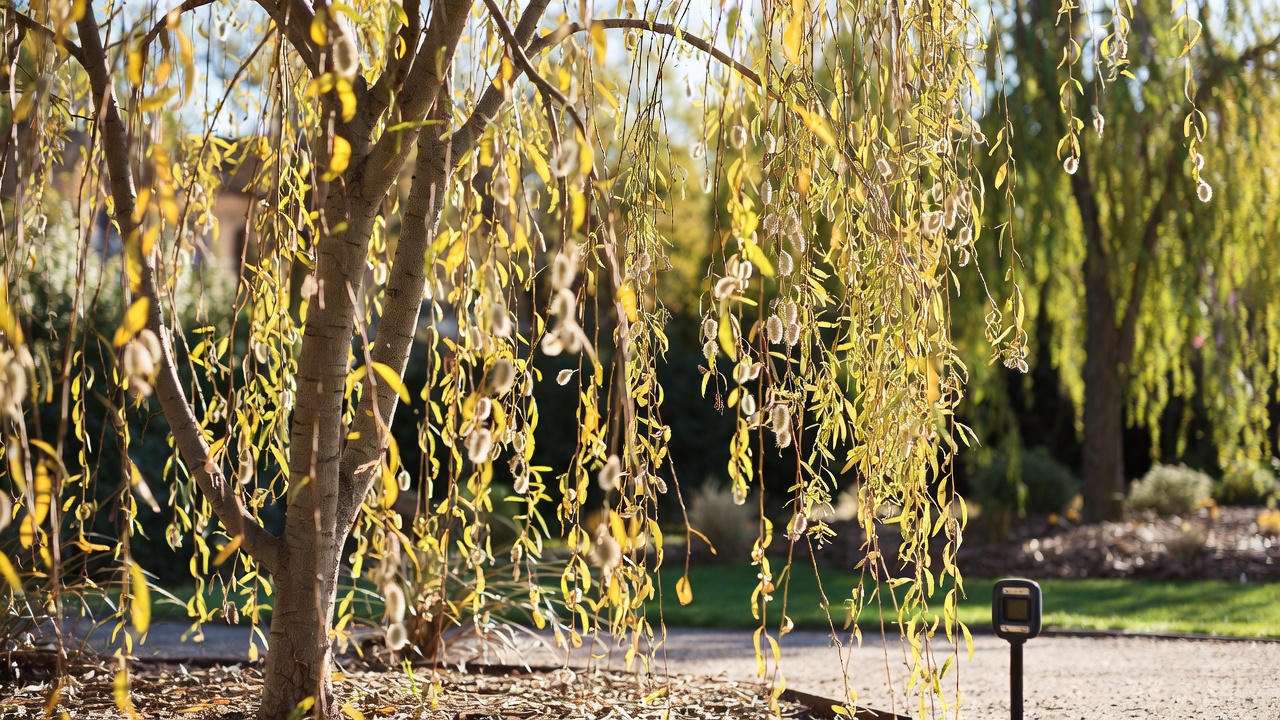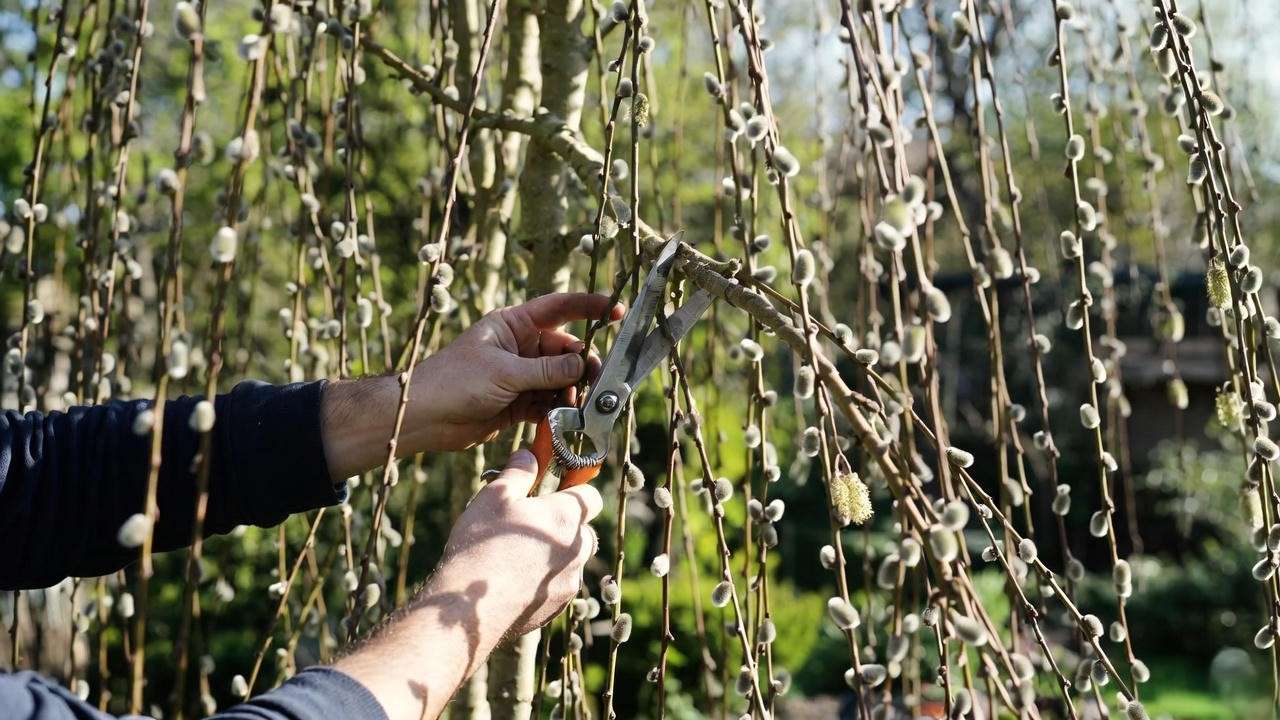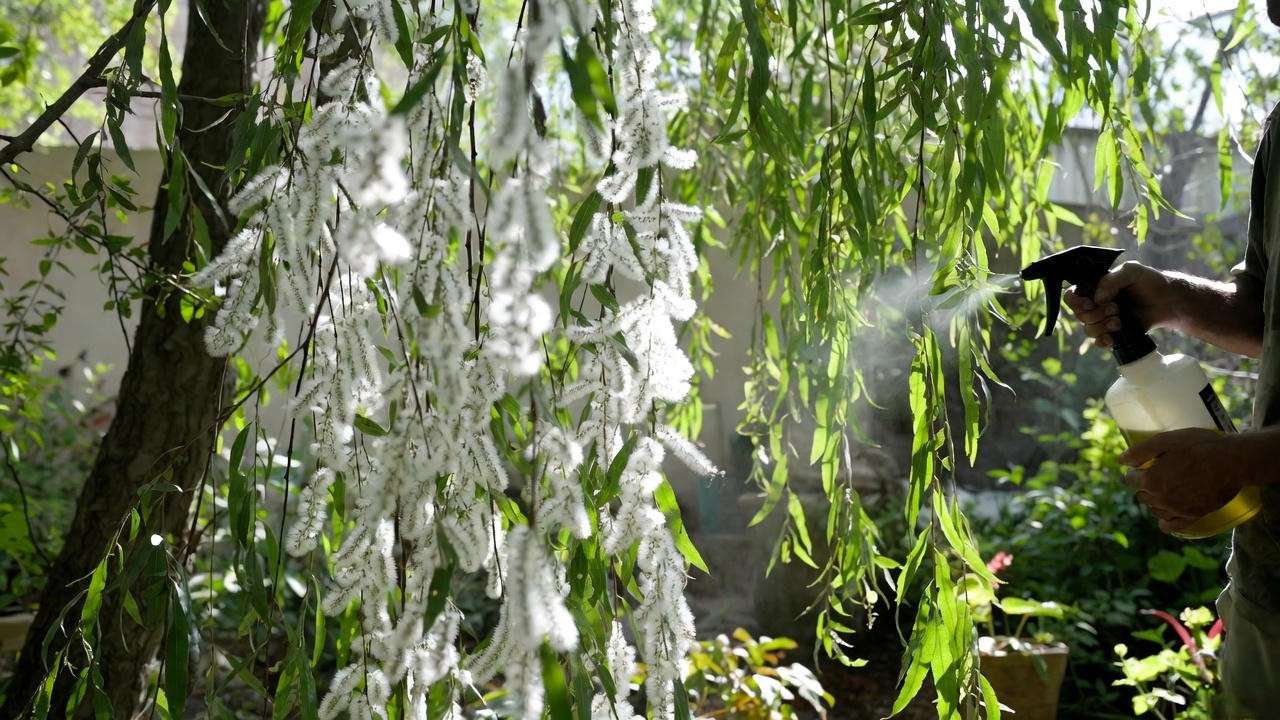Picture this: a graceful weeping pussy willow tree, its cascading branches adorned with soft, fuzzy catkins, stealing the show in your garden. It’s a scene straight out of a fairy tale—but without proper care, this stunning tree can struggle, leaving you with drooping branches and disappointment. Whether you’re a seasoned gardener or a newbie, mastering weeping pussy willow tree care is the key to unlocking its full potential. In this guide, I’ll share 7 expert-backed tips to ensure your tree thrives year-round, from planting to pruning and beyond. With over a decade of horticulture experience and insights from top arborist resources, this article will be your go-to for keeping your weeping pussy willow healthy and vibrant. Let’s dive in! 🌿
1. Understanding the Weeping Pussy Willow Tree 🌱
What Makes the Weeping Pussy Willow Special?
The weeping pussy willow tree, scientifically known as Salix caprea ‘Pendula’, is a dwarf cultivar of the classic pussy willow, cherished for its compact size and dramatic, cascading branches. Unlike its larger relatives, this ornamental gem typically grows to 6-8 feet tall and wide, making it perfect for small gardens, patios, or even large containers. Its hallmark feature? The soft, silvery catkins that emerge in early spring, often before the leaves, creating a striking display that attracts pollinators like bees and butterflies 🐝.
This tree’s versatility is another reason it’s a gardener’s favorite. Use it as a focal point in a landscape, a natural privacy screen, or even harvest its catkins for floral arrangements. Its weeping form adds a touch of elegance, but to keep it thriving, you need to understand its unique needs.

Key Characteristics to Know
- Growth Rate: Moderate, adding 1-2 feet per year under ideal conditions.
- Hardiness Zones: Thrives in USDA Zones 4-8, tolerating cold winters and mild summers.
- Lifespan: With proper care, expect 20-30 years of beauty.
- Foliage and Flowers: Oval green leaves follow the fuzzy catkins, which bloom in shades of white or yellow.
Expert Insight: The weeping pussy willow’s early catkins are a vital food source for pollinators, making it an eco-friendly addition to any garden. By planting one, you’re supporting local biodiversity! 🌼
2. Choosing the Perfect Spot for Your Tree 🌞
Where to Plant Your Weeping Pussy Willow
Location is everything when it comes to a healthy weeping pussy willow tree. Choose a spot that balances sunlight, soil, and space to set your tree up for success. These trees prefer full sun to partial shade, meaning at least 6 hours of direct sunlight daily, though they can tolerate some afternoon shade in hotter climates.
Soil is another critical factor. Weeping pussy willows thrive in moist, well-draining soil and can handle clay or loamy conditions, but they won’t tolerate waterlogged roots. Before planting, test your soil’s drainage by digging a 12-inch hole, filling it with water, and checking how quickly it drains. If it takes longer than 2 hours, amend the soil or choose a different spot.
Tip: Avoid planting near foundations, septic systems, or underground pipes, as the tree’s roots can be invasive over time. Space it 6-10 feet from other plants or structures to give it room to spread.
Preparing the Planting Site
To give your tree a strong start:
- Test Soil pH: Aim for a slightly acidic to neutral range (6.0-7.0). Most garden centers offer affordable soil testing kits.
- Amend the Soil: Mix in organic matter like compost or peat moss to improve drainage and fertility.
- Clear Debris: Remove rocks, weeds, or grass from the planting area to reduce competition.
Example: A reader once shared that their weeping pussy willow suffered from root rot due to planting in a low-lying, poorly drained area. By relocating the tree to a raised bed with amended soil, they saved it! Proper site prep can make all the difference.
3. Planting Your Weeping Pussy Willow Like a Pro 🌳
Step-by-Step Planting Guide
Timing is crucial for planting a weeping pussy willow tree. The best seasons are early spring or fall, when cooler temperatures promote root establishment without stressing the tree. Follow these steps for success:
- Dig the Hole: Make it twice as wide and as deep as the root ball (typically 18-24 inches for a nursery tree).
- Position the Tree: Place the tree so the graft union (the bulge where the weeping cultivar is grafted onto the rootstock) sits 2 inches above soil level. This prevents rot and ensures stability.
- Backfill: Fill the hole with a mix of native soil and compost, gently tamping down to eliminate air pockets.
- Water Thoroughly: Soak the soil to settle the roots, adding 1-2 gallons for a young tree.
- Mulch: Apply a 2-3 inch layer of organic mulch (like bark or wood chips) around the base, keeping it 2 inches from the trunk to prevent rot.

Container vs. Ground Planting
For small spaces or patios, growing a weeping pussy willow in a container is a fantastic option. Choose a 15-20 gallon pot with drainage holes and fill it with a high-quality potting mix blended with compost. Container-grown trees need more frequent watering and fertilizing but offer flexibility—you can move them to optimize sunlight or protect them in harsh winters.
Expert Tip: Stake young trees, whether in the ground or a pot, to support their weeping form during the first 1-2 years. Use a sturdy stake and soft ties to avoid damaging the trunk.
4. Watering Wisely for a Healthy Tree 💧
How Much Water Does Your Tree Need?
Weeping pussy willows love moisture, but balance is key. For newly planted trees, water 1-2 times per week, providing about 1 inch of water each time. Once established (after 1-2 years), they’re more drought-tolerant but still prefer consistently moist soil. Check the top 2 inches of soil—if it feels dry, it’s time to water.
Watch for signs of trouble:
- Overwatering: Yellowing leaves, soggy soil, or a musty smell.
- Underwatering: Wilting branches, dry soil, or leaf drop.
Tool Recommendation: A soil moisture meter (available for $10-20 online) takes the guesswork out of watering, ensuring you hit the sweet spot.

Seasonal Watering Adjustments
- Spring/Summer: Increase watering during hot, dry spells, especially for container trees. Aim for deep, infrequent sessions to encourage strong roots.
- Fall/Winter: Reduce watering as the tree enters dormancy, but monitor for drought in mild climates. A good soak every 2-3 weeks may be needed.
Pro Tip: Mulching not only conserves moisture but also regulates soil temperature, reducing watering needs in summer.
5. Pruning for Shape and Health ✂️
When and How to Prune Your Weeping Pussy Willow
Pruning is essential to maintain the weeping pussy willow’s elegant shape, promote catkin production, and remove unhealthy growth. The best time to prune is late winter or early spring, just before new growth begins. This minimizes stress and allows wounds to heal quickly.
Follow these steps:
- Sanitize Tools: Use clean, sharp pruning shears or loppers, disinfected with rubbing alcohol to prevent disease spread.
- Remove Dead/Damaged Wood: Cut back any broken, diseased, or crossing branches to improve air circulation.
- Shape the Canopy: Trim overly long branches to maintain the desired weeping form, cutting just above a healthy bud.
- Thin Sparingly: Remove no more than 20% of the canopy to avoid stressing the tree.
Step-by-Step Example: To shorten a branch, locate a healthy outward-facing bud, and make a clean, angled cut ¼ inch above it. This encourages new growth in the right direction.

Common Pruning Mistakes to Avoid
- Over-Pruning: Removing too much can reduce catkin production and weaken the tree.
- Improper Cuts: Avoid leaving stubs (which invite pests) or cutting too close to the trunk (which damages healthy tissue).
- Wrong Timing: Pruning in fall or summer can make the tree vulnerable to pests or frost.
Case Study: A community garden I worked with had a weeping pussy willow that looked lopsided due to years of haphazard pruning. By selectively thinning and shaping over two seasons, we restored its graceful form, and it produced abundant catkins the following spring.
6. Fertilizing and Feeding Your Tree 🍃
Nutrient Needs for Vibrant Growth
To keep your weeping pussy willow tree lush and healthy, proper fertilization is crucial. These trees aren’t heavy feeders, but they benefit from a nutrient boost to support their vibrant catkins and foliage. Use a balanced, slow-release fertilizer with a 10-10-10 NPK ratio (nitrogen, phosphorus, potassium) or opt for organic alternatives like well-rotted compost or fish emulsion.
When to Fertilize: Apply fertilizer in early spring, just before bud break, to fuel new growth. A single application is usually enough for the year, but container-grown trees may need a second, lighter feeding in mid-summer.
How to Apply:
- Measure the fertilizer based on the tree’s size (follow label instructions—typically 1-2 tablespoons for a young tree).
- Spread it evenly in a ring around the tree, starting 6 inches from the trunk and extending to the drip line (where the branches end).
- Water thoroughly to help nutrients soak into the soil.
Warning: Over-fertilizing can cause root burn or excessive, weak growth that’s prone to pests. If you notice leaf scorch or unusually soft branches, skip fertilizing for the season and flush the soil with water.
Signs Your Tree Needs Nutrients
Keep an eye out for these red flags:
- Yellowing Leaves: Often a sign of nitrogen deficiency.
- Stunted Growth: Indicates a lack of phosphorus or potassium.
- Sparse Catkins: Could point to overall nutrient imbalance.
To confirm, test your soil annually using a kit from your local garden center or extension service. This helps you tailor your fertilization plan to your tree’s specific needs.
Expert Insight: Organic mulch, like shredded bark or compost, does double duty as a slow-release fertilizer. As it decomposes, it enriches the soil, reducing the need for synthetic products. Apply a 2-3 inch layer annually, keeping it away from the trunk to prevent rot.
7. Protecting Your Tree from Pests and Diseases 🐛
Common Threats to Weeping Pussy Willows
Weeping pussy willows are relatively hardy, but they’re not immune to pests and diseases. Regular monitoring and preventive care can keep these issues at bay. Here are the most common culprits:
- Pests:
- Aphids: Tiny sap-sucking insects that cause curled leaves. Control with a strong water spray or insecticidal soap.
- Scale: Hard, shell-like pests that weaken branches. Apply neem oil or horticultural oil in early spring.
- Caterpillars: Chew through leaves, leaving holes. Hand-pick or use Bacillus thuringiensis (Bt), an organic pesticide.
- Diseases:
- Powdery Mildew: White, powdery coating on leaves, common in humid conditions. Improve air circulation and apply a fungicide if severe.
- Root Rot: Caused by waterlogged soil, leading to wilting and decay. Prevent with proper drainage and avoid overwatering.
- Canker: Sunken, discolored areas on branches. Prune affected areas and disinfect tools to prevent spread.
Preventive Measures:
- Space trees properly to ensure good air circulation.
- Inspect regularly for early signs of trouble, especially in spring and summer.
- Maintain overall tree health through proper watering and fertilization.

Seasonal Care to Boost Resilience
- Spring: Apply neem oil as a preventive pest treatment before buds open.
- Summer: Monitor for fungal diseases during humid weather; remove affected leaves promptly.
- Fall: Clear fallen leaves and debris to prevent pests and pathogens from overwintering.
- Winter: Check for rodent damage in colder climates and wrap trunks with guards if needed.
FAQ Answer: Can my tree recover from root rot? Yes, if caught early. Stop watering, improve drainage (e.g., by aerating the soil), and remove damaged roots. In severe cases, consult an arborist.
8. Year-Round Care Calendar 📅
A Monthly Guide to Weeping Pussy Willow Care
To simplify your weeping pussy willow tree care, here’s a month-by-month checklist to keep your tree thriving:
- January-February (Late Winter):
- Prune to shape and remove dead wood.
- Check for winter damage and protect young trees with burlap in harsh climates.
- March-April (Early Spring):
- Plant new trees or transplant existing ones.
- Apply slow-release fertilizer and mulch.
- Spray neem oil to deter early pests.
- May-June (Late Spring/Summer):
- Water deeply during dry spells, especially for container trees.
- Monitor for aphids, caterpillars, or powdery mildew.
- July-August (Mid-Summer):
- Continue watering and check soil moisture.
- Thin dense branches if needed to improve airflow.
- September-October (Fall):
- Reduce watering as the tree prepares for dormancy.
- Clear fallen leaves to prevent disease.
- November-December (Early Winter):
- Inspect for rodent or storm damage.
- Add a fresh layer of mulch to insulate roots.
Visual Aid: Download our free Weeping Pussy Willow Care Calendar PDF (linked at the end) for a printable version of this schedule, complete with reminders and tips! 🌟
9. Troubleshooting Common Problems 🔧
Why Isn’t My Weeping Pussy Willow Thriving?
Even with the best care, issues can arise. Here’s how to diagnose and fix common problems:
- Drooping Branches:
- Normal: The tree’s weeping form naturally droops.
- Problem: Excessive drooping with wilting leaves may indicate underwatering, root rot, or pest stress. Check soil moisture and inspect for aphids or scale.
- No Catkins:
- Causes: Over-pruning, nutrient deficiency, or insufficient sunlight.
- Fix: Prune lightly, fertilize in spring, and ensure 6+ hours of sun daily.
- Leaf Drop:
- Causes: Environmental stress (drought, overwatering) or pests like caterpillars.
- Fix: Adjust watering, inspect for pests, and test soil for nutrient imbalances.
Reader Q&A: A gardener emailed me asking why their tree’s leaves were browning at the edges. After ruling out overwatering, we discovered their soil was too alkaline (pH 8.0). Adding sulfur to lower the pH to 6.5 resolved the issue, and the tree bounced back by the next season.
Conclusion 🎉
Caring for a weeping pussy willow tree doesn’t have to be daunting. By following these 7 essential tips—choosing the right spot, planting correctly, watering wisely, pruning thoughtfully, fertilizing appropriately, protecting against pests, and maintaining a year-round care routine—you’ll ensure your tree remains a stunning centerpiece in your garden for decades. Start small, observe your tree’s needs, and enjoy the beauty of its cascading branches and fuzzy catkins each spring.
Call to Action: Have a weeping pussy willow success story or a question? Share it in the comments below—I’d love to hear from you! For more tree care tips, subscribe to our newsletter or download our free Weeping Pussy Willow Care Checklist to keep your tree thriving. 🌳













